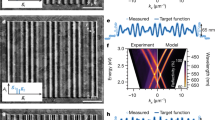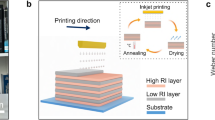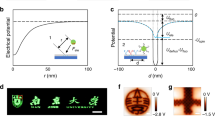Abstract
The interaction of electromagnetic waves with matter can be controlled by structuring the matter on the scale of the wavelength of light, and various photonic components have been made by structuring materials using top-down or bottom-up approaches1,2,3,4,5. Dip-pen nanolithography is a scanning-probe-based fabrication technique that can be used to deposit materials on surfaces with high resolution and, when carried out in parallel, with high throughput6,7,8. Here, we show that lyotropic optical diffraction gratings—composed of biofunctional lipid multilayers with controllable heights between ∼5 and 100 nm—can be fabricated by lipid dip-pen nanolithography. Multiple materials can be simultaneously written into arbitrary patterns on pre-structured surfaces to generate complex structures and devices, allowing nanostructures to be interfaced by combinations of top-down and bottom-up fabrication methods. We also show that fluid and biocompatible lipid multilayer gratings allow label-free and specific detection of lipid–protein interactions in solution. This biosensing capability takes advantage of the adhesion properties of the phospholipid superstructures and the changes in the size and shape of the grating elements that take place in response to analyte binding.
This is a preview of subscription content, access via your institution
Access options
Subscribe to this journal
Receive 12 print issues and online access
$259.00 per year
only $21.58 per issue
Buy this article
- Purchase on Springer Link
- Instant access to full article PDF
Prices may be subject to local taxes which are calculated during checkout




Similar content being viewed by others
References
Rittenhouse, D. Explanation of an optical deception. Trans. Am. Phil. Soc. 2, 37–42 (1786).
Choi, S. Y., Mamak, M., von Freymann, G., Chopra, N. & Ozin, G. A. Mesoporous Bragg stack color tunable sensors. Nano Lett. 6, 2456–2461 (2006).
Joannopoulos, J. D., Villeneuve, P. R. & Fan, S. H. Photonic crystals: putting a new twist on light. Nature 386, 143–149 (1997).
Ebbesen, T. W., Lezec, H. J., Ghaemi, H. F., Thio, T. & Wolff, P. A. Extraordinary optical transmission through sub-wavelength hole arrays. Nature 391, 667–669 (1998).
Pendry, J. B., Schurig, D. & Smith, D. R. Controlling electromagnetic fields. Science 312, 1780–1782 (2006).
Piner, R. D., Zhu, J., Xu, F., Hong, S. H. & Mirkin, C. A. ‘Dip-pen’ nanolithography. Science 283, 661–663 (1999).
Ginger, D. S., Zhang, H. & Mirkin, C. A. The evolution of dip-pen nanolithography. Angew. Chem. Int. Ed. 43, 30–45 (2004).
Salaita, K., Wang, Y. H. & Mirkin, C. A. Applications of dip-pen nanolithography. Nature Nanotech. 2, 145–155 (2007).
Phillips, R., Ursell, T., Wiggins, P. & Sens, P. Emerging roles for lipids in shaping membrane-protein function. Nature 459, 379–385 (2009).
Sackmann, E. Supported membranes: scientific and practical applications. Science 271, 43–48 (1996).
Chiu, D. T. et al. Chemical transformations in individual ultrasmall biomimetic containers. Science 283, 1892–1895 (1999).
Karlsson, A. et al. Molecular engineering—networks of nanotubes and containers. Nature 409, 150–152 (2001).
Storm, G. & Crommelin, D. J. A. Liposomes: quo vadis? Pharm. Sci. Technol. Today 1, 19–31 (1998).
Radler, J. O., Koltover, I., Salditt, T. & Safinya, C. R. Structure of DNA–cationic liposome complexes: DNA intercalation in multilamellar membranes in distinct interhelical packing regimes. Science 275, 810–814 (1997).
Lenhert, S., Sun, P., Wang, Y. H., Fuchs, H. & Mirkin, C. A. Massively parallel dip-pen nanolithography of heterogeneous supported phospholipid multilayer patterns. Small 3, 71–75 (2007).
Wang, Y. H. et al. A self-correcting inking strategy for cantilever arrays addressed by an inkjet printer and used for dip-pen nanolithography. Small 4, 1666–1670 (2008).
Sekula, S. et al. Multiplexed lipid dip-pen nanolithography on subcellular scales for the templating of functional proteins and cell culture. Small 4, 1785–1793 (2008).
Diguet, A., Le Berre, M., Chen, Y. & Baigl, D. Preparation of phospholipid multilayer patterns of controlled size and thickness by capillary assembly on a microstructured substrate. Small 5, 1661–1666 (2009).
Sanii, B. & Parikh, A. N. Patterning fluid and elastomeric surfaces using short-wavelength UV radiation and photogenerated reactive oxygen species. Annu. Rev. Phys. Chem. 59, 411–432 (2008).
Tamir, T. & Peng, S. T. Analysis and design of grating couplers. Appl. Phys. 14, 235–254 (1977).
Henzi, P., Rabus, D. G., Bade, K., Wallrabe, U. & Mohr, J. Low cost single mode waveguide fabrication allowing passive fiber coupling using LIGA and UV flood exposure. Proc. SPIE 5454, 64–74 (2004).
Abouraddy, A. F. et al. Towards multimaterial multifunctional fibres that see, hear, sense and communicate. Nature Mater. 6, 336–347 (2007).
Bonifacio, L. D., Lotsch, B. V., Puzzo, D. P., Scotognella, F. & Ozin, G. A. Stacking the nanochemistry deck: structural and compositional diversity in one-dimensional photonic crystals. Adv. Mater. 21, 1641–1646 (2009).
Mendez-Vilas, A., Jodar-Reyes, A. B. & Gonzalez-Martin, M. L. Ultrasmall liquid droplets on solid surfaces: production, imaging and relevance for current wetting research. Small 5, 1366–1390 (2009).
Nagle, J. F. & Tristram-Nagle, S. Structure of lipid bilayers. BBA Rev. Biomembranes 1469, 159–195 (2000).
Sanii, B. & Parikh, A. N. Surface-energy dependent spreading of lipid monolayers and bilayers. Soft Matter 3, 974–977 (2007).
Nissen, J., Gritsch, S., Wiegand, G. & Radler, J. O. Wetting of phospholipid membranes on hydrophilic surfaces—concepts towards self-healing membranes. Eur. Phys. J. B 10, 335–344 (1999).
Radler, J., Strey, H. & Sackmann, E. Phenomenology and kinetics of lipid bilayer spreading on hydrophilic surfaces. Langmuir 11, 4539–4548 (1995).
Ulrich, A. S., Sami, M. & Watts, A. Hydration of DOPC bilayers by differential scanning calorimetry. BBA Biomembranes 1191, 225–230 (1994).
Rentzhog, M. & Fogden, A. Print quality and resistance for water-based flexography on polymer-coated boards: dependence on ink formulation and substrate pretreatment. Prog. Org. Coat. 57, 183–194 (2006).
Lai, Z. A., Wang, Y. L., Allbritton, N., Li, G. P. & Bachman, M. Label-free biosensor by protein grating coupler on planar optical waveguides. Opt. Lett. 33, 1735–1737 (2008).
Fan, X. D. et al. Sensitive optical biosensors for unlabeled targets: a review. Anal. Chim. Acta 620, 8–26 (2008).
Morhard, F., Pipper, J., Dahint, R. & Grunze, M. Immobilization of antibodies in micropatterns for cell detection by optical diffraction. Sens. Actuat. B 70, 232–242 (2000).
Kumar, A. & Whitesides, G. M. Patterned condensation figures as optical diffraction gratings. Science 263, 60–62 (1994).
Zhang, M. et al. A MEMS nanoplotter with high-density parallel dip-pen manolithography probe arrays. Nanotechnology 13, 212–217 (2002).
Acknowledgements
The authors thank W. Schroeder for drawing Fig. 1, T. Heiler for Fig. 3a, and A.B. Thistle for editorial review. S.L. thanks S. Gaertner, M. Ruben and L.F. Chi for discussion. S.L. and H.F. thank the Deutsche Forschungsgemeinschaft (DFG, German Research Foundation, project FU 299/14-1) for financial support. S.S. and S.L. acknowledge funding from the DFG Center for Functional Nanomaterials (CFN E3.2). T.M.'s Young Investigator Group YIG 08 received financial support from the ‘Concept for the Future’ of Karlsruhe Institute of Technology within the framework of the German Excellence Initiative. C.V. and S.K. acknowledge financial support from the Karlsruhe School of Optics and Photonics.
Author information
Authors and Affiliations
Contributions
S.L. conceived the study, coordinated experiments and wrote the paper. F.B. carried out the initial DPN and characterization, and T.L. advanced the sensing experiments with contributions from S.L., S.W., M.X. and S.S. The grating coupler was developed by C.V., S.K. and T. M. T.S. and H.F. contributed significantly to the scientific discussion of the project.
Corresponding author
Ethics declarations
Competing interests
The authors declare no competing financial interests.
Supplementary information
Supplementary information
Supplementary information (PDF 1134 kb)
Supplementary information
Supplementary movie 1 (AVI 12881 kb)
Supplementary information
Supplementary movie 2 (AVI 10849 kb)
Supplementary information
Supplementary movie 3 (WMV 562 kb)
Rights and permissions
About this article
Cite this article
Lenhert, S., Brinkmann, F., Laue, T. et al. Lipid multilayer gratings. Nature Nanotech 5, 275–279 (2010). https://doi.org/10.1038/nnano.2010.17
Received:
Accepted:
Published:
Issue Date:
DOI: https://doi.org/10.1038/nnano.2010.17
This article is cited by
-
Surface plasmons interference nanogratings: wafer-scale laser direct structuring in seconds
Light: Science & Applications (2022)
-
Dip-Pen Nanolithography(DPN): from Micro/Nano-patterns to Biosensing
Chemical Research in Chinese Universities (2021)
-
Atomic force microscopy-based characterization and design of biointerfaces
Nature Reviews Materials (2017)
-
Diffractive Optical Analysis for Refractive Index Sensing using Transparent Phase Gratings
Scientific Reports (2015)
-
Lab on a Biomembrane: Rapid prototyping and manipulation of 2D fluidic lipid bilayer circuits
Scientific Reports (2013)



